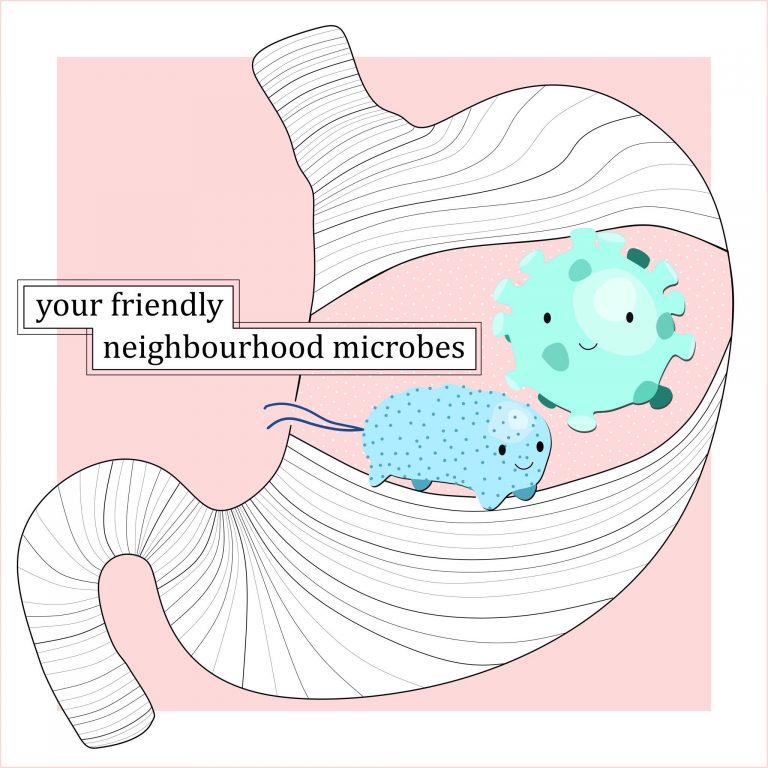
Written by Alexandra Nitoiu
Illustrated by Eugenia Yi
We humans tend to place ourselves on a pedestal above all other organisms, incorrectly assuming that our unique intelligence must correlate with bodies that are more complex than those of other beings. But as it turns out, microbes—that is, microscopic organisms such as bacteria and viruses—actually outnumber the human cells in our bodies ten to one! These microbes mostly live in our guts—specifically the large intestine—and perform a variety of basic functions such as helping digest food, regulating our immune system, protecting against disease-producing bacteria, and synthesizing vitamins. The genes of all the microbes found in an organism are called the “microbiome”, and the host along with its microbiome is a “metaorganism”.
Given their pertinence to human health, it’s surprising that microbiomes haven’t been studied until very recently; in fact, they were only recognized in the late 1990s! Microbiome research really started to take off in 2007, when the National Institutes of Health (NIH) created the Human Microbiome project, whose purpose was to sequence all the DNA of microorganisms that live on and inside humans. So far, the project has found that around 1,000 bacterial strains alone live inside each person, and that microbiomes vary from one individual to another. Even more surprising is that 10,000 species of all types of microbes, such as bacteria and viruses, are estimated to make up the complete human microbiome. But how exactly does the microbiome become established?
Humans are first exposed to microbes as infants when they pass through the birth canal and drink their mother’s breast milk. Babies born via C-section are never exposed to the microbes on their mother’s birth canal, and as a result have different gut microbiomes during the first 6-9 months of their lives than babies born vaginally. This could explain why C-section babies have a slightly higher risk of developing immune-related diseases such as asthma and allergies. But regardless of how an individual is born, their microbiome will continue to change over time, with environment and diet being the major contributors. A recently published study has shown that it’s possible to determine an individual’s age within 4 years of accuracy just by looking at which bacterial species are present in their microbiome! This discovery indicates that common bacterial components of microbiomes change similarly across individuals as they age, a process which scientists may use in the future to evaluate an individual’s health based on their lifestyle, or to test whether certain factors affect longevity.
Other studies introduced microbes from human patients to germ-free mice—mice that are raised to be clear of microbes, i.e. sterile—and found potential links between the microbiome and diabetes, autism, obesity, anxiety, and even mood. Additionally, different types of microbes can affect an individual’s response to certain cancer treatments, either by affecting the ability of the immune system to recognize tumours, or by reacting with the drug to eliminate it from the body. These effects vary among individuals, and are even harder to predict using animal models because animals have different microbiomes than humans. On the other hand, some diseases that are actually caused by gut microbes, like C. difficile, have been cured by fecal transplants from individuals with healthy gut microbiomes. These successes have fostered hope that introducing helpful microbes into patients may one day help treat immune diseases as well. Although scientists don’t know very much about the microbiome yet, it’s one of the most promising new fields of research, and will be useful for developing applications in disease diagnosis and treatment, as well as personalized medicine. If you’ve personally never had to think about your microbiome before, it’s probably because it’s doing a great job of helping your human cells out, and will hopefully continue to do so for the rest of your life. So if you’re ever feeling alone in the future, you can always remember that not only do your own cells have your back, but so do all of the other microbes living on and inside you!
Sources:
- https://ucsdnews.ucsd.edu/pressrelease/more-than-just-a-carnival-trick-researchers-can-guess-your-age-based-on-your-microbes
- https://depts.washington.edu/ceeh/downloads/FF_Microbiome.pdf
- https://www.sciencemag.org/news/2019/01/bacteria-your-gut-may-reveal-your-true-age
- https://www.theguardian.com/news/2018/mar/26/the-human-microbiome-why-our-microbes-could-be-key-to-our-health
- https://www.hsph.harvard.edu/nutritionsource/microbiome/
- https://www.smithsonianmag.com/science-nature/babies-born-c-section-found-have-different-gut-microbes-vaginally-delivered-infants-180973174/
- https://www.nature.com/articles/d41586-019-02807-x